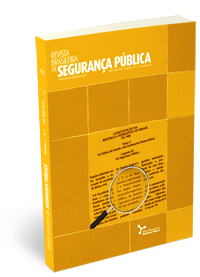Comunidades urbanas, desorganização social e encarceramento
DOI:
https://doi.org/10.31060/rbsp.2012.v6.n1.115Palavras-chave:
Encarceramento, Desorganização social, Crime, Espaço urbanoResumo
O objetivo deste artigo consiste em refletir sobre os efeitos colaterais das políticas de encarceramento massivo sobre comunidadesurbanas. Apresentam-se perspectivas que destacam o impacto do aumento da população prisional sobre as taxas de crime, bemcomo aquelas que alertam para o problema da concentração espacial das taxas de encarceramento em determinadas vizinhanças.Downloads
Referências
ADORNO, S. Crimen, punición y prisiones em Brasil: um retrato sin retoques. Quórum–Revista Iberoamericana, v. 16, p. 41- 49, 2006.
BEATO, C. Crime e cidades. Tese (Professor Titular). Minas Gerais, Universidade Federal de Minas Gerais – UFMG, 2010. Mimeo.
BEATO, C.; REIS, I. A. Desigualdade, desenvolvimento socioeconômico e crime. In: HENRIQUES, R. (Org.). Desigualdade e pobreza no Brasil. Rio de Janeiro: Ipea, 2000, p. 385‐405.
BECKER, H. Conferência: A Escola de Chicago. Mana, v. 2, n. 2, p.177-188, 1996.
BOUNDS, M. Urban social theory: city, self and society. New York: Oxford University Press, 2004.
BURSIK, R. J.; GRASMICK, H. G. Neighborhood‐based networks and the control of crime and delinquency. In: BARLOW, H. D. Crime and public policy: Putting theory to work. Westview Press, 1995.
CLEAR, T.; ROSE, D.; WARING, E.; SCULLY, K. Coercive mobility and crime: a preliminary examination of concentrated incarceration and social disorganization. Justice Quarterly, v. 20, n. 1, p. p. 33-60, 2003.
CLEAR, T. The impacts of incarceration on public safety.Social Research, v. 74, n. 2, p. 613-627, 2007.
COELHO, E. C.. Sobre sociólogos, pobreza e crime. A oficina do diabo e outros estudos sobre criminalidade. Record: Rio de Janeiro, 2005
FELTRAN, G. de S. Crime e castigo na cidade: os repertórios da justiça e a questão do homicídio nas periferias de São Paulo. Caderno CRH, v. 23, n. 58, p. 59-73, 2010.
FOUCAULT, M. Vigiar e punir: nascimento da prisão. Rio de Janeiro: Vozes, 2008.
GOERTZEL, T.; KAHN, T. (The great São Paulo homicide drop. Homicide Studies, v. 13, n. 4, p. 398-410, 2009.
GREENBERG, S.; ROHE, W. Informal social control and crime prevention. In: TAYLOR, R, B. Urban neighborhoods: research and policy. Praeger Publishers, 1986.
LAURITSEN, J.; SAMPSON, R. Minorities, crime, and criminal justice. The handbook of crime and punishment. New York: Oxford University Press, 1998.
LEVITT, S. D. Understanding why crime fell in the 1990s: four factors that explain the decline and six that do not. Journal of Economic Perspectives, v. 18, n. 1, p.163-190, 2004.
LYNCH, J. P.; SABOL, W. J. Assessing the effects of mass incarceration on informal social control in communities. Criminology & Public Policy, v. 3, n. 2, p. 267-294, 2004.
ROSE, D.; CLEAR, T. Incarceration, social capital and crime: implications for social disorganization theory. Criminology, v. 36, n. 3, p. 441- 471, 1998.
SAMPSON, R. Urban disorder, crime and neighborhood collective efficacy. Edited version of paper presented at the Seminario Internacional: Politicas De Prevencion Del Crimen Y La Violencia En Ambitos Urbanos, Bogotá, Colombia, May 2003.
SAMPSON, R.t J.; WILSON, W. J. Toward a theory of race, crime and urban inequality. In: SHAUN, L.; GABBIDEN, T. G. (Eds.). Race, crime and justice. New York:Rotledge, 2005.
SAMPSON, R. J.; GROVES, W. B. Community structure and crime: testing social disorganization theory. American Journal of Sociology, v. 94, n. 4, p. 774-802, 1989.
SHAW, C.; MCKAY, H. Juvenile delinquency in urban areas. Chicago: University of Chicago Press, 1969.
TONRY, M.; PETERSILLA, J. American prisons at the beginning of the twenty first century. Crime and Justice, v. 26, p. 1-16, 1999.
WACQUANT, L. J. D. Crime e castigo nos Estados Unidos: de Nixon a Clinton. Revista de Sociologia e Política, n. 13, p.39-50, 1999.
Downloads
Publicado
Como Citar
Edição
Seção
Licença
Copyright (c) 2012 Revista Brasileira de Segurança Pública

Este trabalho está licenciado sob uma licença Creative Commons Attribution 4.0 International License.
Licenciamento
A Revista Brasileira de Segurança Pública usa a Licença Creative Commons como forma de licenciamento para suas obras publicadas. A licença utilizada segue o modelo CC BY 4.0 - Attribution 4.0 International.
Para consultar os dirietos permitidos direcione-se para a licença completa ou para a nossa página de Direitos dos autores e Licenças.



